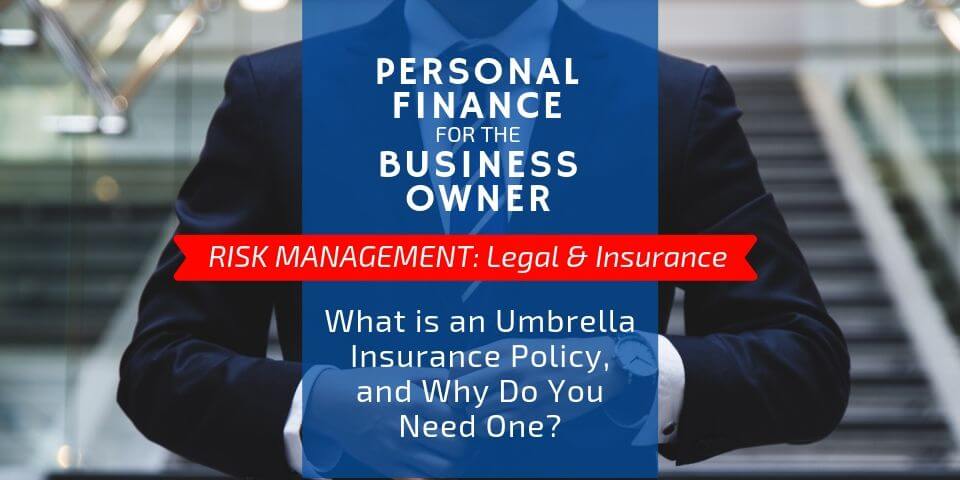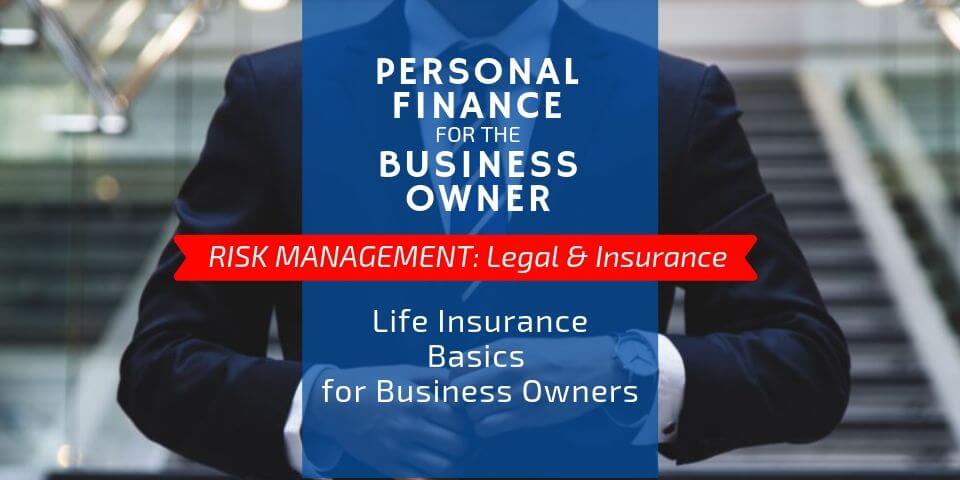
What is an Umbrella Insurance Policy and Why Do You Need One?
July 25, 2019
Personal Disability Insurance – Policy Types Needed by Business Owners
August 20, 2019Life Insurance Basics – Considerations for Business Owners

When my firm begins working with business owners, we often have to correct, fix, improve, or shore up their life insurance policies. Many times, the client won’t have the right insurances, or they’re paying too much for coverage. And sometimes, the client won’t even have a life insurance policy. So right off the bat, when my personal planning process begins, the team helps place the clients into the correct life insurance policies. I want you to have a baseline understanding of how we make life insurance financially simple, so let’s cover the basics of Life Insurance for business owners.
Podcast Time Index for “Life Insurance 101 for Business Owners”
- 01:20 – Life Insurance 101 For Business Owners
- 03:28 – What is Life Insurance?
- 04:22 – Do You Need it?
- 06:31 – Types of Life Insurance: Term Insurance
- 08:42 – Whole Life
- 11:10 – Variable
- 12:06 – Universal
- 13:13 – Index
- 14:08 – What Type of Insurance Do You Need?
- 16:43 – How Much Do You Need?
- 19:52 – Wrap Up
What is Life Insurance?
Sure, we all know what life insurance is. You pay a company to provide your beneficiary with the death benefit upon your death. However, to me, life insurance is a love letter. It’s a love letter you leave to those you love the most to say, “Hey, I’ve got this. I’m taking care of you after my life is over.”
Do You Need Life Insurance?
You might ask yourself: “do I really need it?” Well, the answer to that comes in the form of another question. Does someone rely on you financially?
If you’re a business owner, someone is relying on you financially. Maybe it’s a team of employees, customers with contracts, or vendors with invoices to be paid. Employees depend on paychecks from your business to pay their bills. Customers depend on you to provide them with products or services. Vendors depend on your payments to cover their expenses. If something happens to you, that’s a lot of people left in the lurch. So, you need life insurance. Therefore, let’s explore some life insurance strategies for business owners.
You say, “Well, Justin, I’m not a business owner at this time. I just want to learn about business.” Okay, that’s fine. Does someone rely on you financially? Do you have children? Are you married? Do you have a significant other? If any of those are the case, then yes, somebody relies on you financially. You probably need life insurance.
I realize that most people don’t want to think about or talk about dying. However, if you don’t prepare for the financial consequences of your death, you could leave those who rely on you destitute. Therefore, you need life insurance.
What Are the Different Types of Life Insurance?
If you’re buying life insurance, you need to know what different types exist. Essentially, there are two basic types of life insurance: term and permanent.
Term Life Insurance
A term insurance policy covers you for a certain period of time – a term. Typically, the term will be in 10-year increments, so you’ll most often buy a 10-year, a 20-year, or a 30-year policy.
- If you buy a level term policy, the premiums and the death benefit remain constant for that term.
- Under a decreasing term policy, your premiums and your death benefit will decrease over time.
- With an annual renewable term policy, your policy renews automatically each year at a new price point, but the death benefit remains the same.
Permanent Life Insurance
On the permanent side of life insurance, things get a little murkier. A term policy is there to cover you IF you die, whereas a whole life or permanent product is there WHEN you die.
- One type of permanent life insurance is universal life, often loosely called a term-for-life policy. In this type of policy, you can turn your premium dollars up to a maximum amount or down to a minimum amount. I most commonly see this policy ‘sold’ where the insured pays a small premium during the first few years of the policy to hold a large death benefit. However, as the insured ages, the insurance company will require you to pay more money into the policy. So your premiums could end up sky-rocketing over the years.
- If you buy a whole life policy, the insurance company wants the death benefit to equal the cash value (the amount of money in excess of the policy fees) by the time you turn 100 or 120 years old. So if you start off at age 20, your premiums may not be very much. If you start off at age 80, you’ll only have 20 years to accumulate $1 million in coverage in cash value. Therefore, you’re going to have extremely high premiums, and the reason the insurance companies build it that way is for stability. The older you get, the more likely you are going to die, and insurance companies want the money you’ve invested with them to cover your death benefit.
- An index life policy uses a whole life chassis, and the policy will have a cash value. However, that cash value’s going to be tied to, or benched by the growth of an equity index like the S&P 500, the Russell 1000, and the MCSI Index. While you can not invest directly into an index, the insurance companies will provide the indexes which fit their pricing model.
- A variable life policy also uses a whole life chassis, but the insurance company does not control the cash value of the policy. Instead, you invest (you have to have a securities license to deal with this) the cash value of the policy into separately managed accounts (also called sub-accounts). Now, these look and smell like mutual funds or Exchange Traded Funds, but they’re not. They’re what’s called “Separate Managed Accounts.” But for the most part, you can invest your cash value directly into the stock market. If the market goes up, then your cash value will increase at market rates less the fees of the separately managed account.
- A second-to-die life policy can help older individuals who are trying to do some estate planning. It pays after the second person of a couple dies, and it works well to equalize your estate among your children.
RELATED READING: A Second-to-Die Life Insurance Policy Can Help Reduce Estate Taxes
What Type of Life Insurance Do You Need?
When selecting a life insurance policy, you want to get either a twenty-year or a thirty-year term policy. Most people can get by with the twenty-year term, but I opted for the thirty-year policy. Why? Well, both my father and my grandfather passed away before they were seventy years old. At forty years old myself, a thirty-year policy will take me to age seventy and provide a benefit to my loved ones in the event of my death. Surprisingly, the difference in cost between the twenty and thirty-year policies was mere pennies on the dollar at the time I purchased my policy. So for me, it made the decision to get the longer coverage quite simple. But more often than not, the 20-year term policy will have the lowest pricing as it is a more competitive product.
You will also want to make sure that the policy you choose is fully convertible for the length of the term. This means that at any point, the policy can be changed from a term policy to a permanent one. A fully convertible policy will ensure that even if you develop a major health issue, you will be able to have the coverage that you need. I have a client right now who is a business owner in his early sixties and his wife has been diagnosed with early-onset dementia. With a fully convertible policy, they will be able to convert her term coverage to a permanent one in the event that she lives a long life, regardless of her health and pre-existing conditions.
How Much Coverage Do You Need?
Many people like to use a rule of ten times the amount of your income. If you make $50,000 per year, you would want to take out a policy that pays out $500,000. However, I am not a fan of this particular school of thought because it is actually quite prohibitive to your loved ones and those who depend on you for their income. Instead, I wish to pay off all outstanding debts so that my wife and kids are never left shouldering that burden. Beyond that, I want to also leave them enough to live on. This means that whatever our annual expenses are, there is enough of a benefit to carry them well into the future.
In order to calculate the amount of coverage that you will need, start with enough to pay off all of your debt. If you have $500,000 in debt, obviously, you would need at least that amount in coverage. But you need to also be aware of your annual expenses and provide a benefit that will cover these costs as well. When I chose my policy, I knew that I wanted to be able to send all of my children to college and I wanted my sweet wife, Emily, to never have to work another day in her life. I take this responsibility of providing for her very seriously and so I have made sure that she will have enough money to care for her long after my demise.
I also have a team of people in my business that depend on me for their own livelihoods and I have factored this into my coverage as well. There must be enough of a benefit to carry them until they are able to find a new “Justin” to take my place in the business. So my death benefit must be enough to cover my debt, my wife, my kids, and my business. I have seen life insurance policies as high as 45-million dollars. While most policies death benefits are under $5-million in coverage.
Remember, life insurance ratings are based on insurability – I understand that not everybody is as healthy as I am right now – but the cost of this amount of coverage isn’t as much as you might think. It is worth your time and your family’s future to check into what type of plans are available to you and what kind of premiums you might expect to pay.
Life is hard sometimes. It can be hectic and difficult but it doesn’t always need to be this way. With the proper coverage, at least that part of your life can be financially simple.
Be sure to join us in our next article discussing the pros and cons of using a life insurance policy to fund a retirement.



